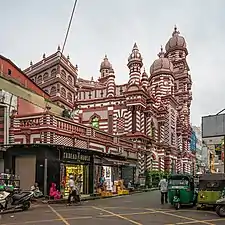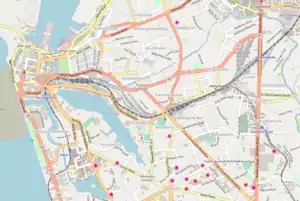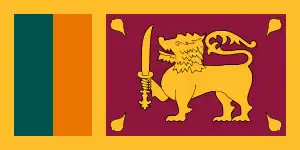| Jami Ul-Alfar Mosque කොලඹ කොටුව රතු පල්ලිය கொழும்பு புறக்கோட்டை சம்மாங்கோடு பள்ளிவாசல் (மஸ்ஜிதுல் ஜாமிஉல் அஃபார்) | |
|---|---|
 The distinctive red and white minarets of Jami Ul-Afar | |
| Religion | |
| Affiliation | Islam |
| Location | |
| Location | Pettah, Colombo, Sri Lanka |
 Shown within Central Colombo | |
| Geographic coordinates | 6°56′19″N 79°51′06″E / 6.9385°N 79.8518°E |
| Architecture | |
| Type | mosque |
| Style | Indo-Saracenic |
| Groundbreaking | 1908 |
| Completed | 1909 |
| Website | |
| redmasjid | |
Jami-Ul-Alfar Mosque (Sinhala: කොලඹ කොටුව රතු පල්ලිය, romanized: Kolomba Kotuwa Rathu Palliya, Tamil: மஸ்ஜிதுல் ஜாமிஉல் அஃபார் அல்லது சம்மாங்கோடு பள்ளிவாசல், romanized: Sammankodu Pallivasal, (known colloquially as the Samman Kottu Palli,[1] Rathu Palliya, Red Masjid or the Red Mosque) is a historic mosque in Colombo, Sri Lanka. It is located on Second Cross Street in Pettah. The mosque is one of the oldest mosques in Colombo and a popular tourist site in the city.
History
Construction of the Jami-Ul-Alfar Mosque commenced in 1908 and the building was completed in 1909.[2][3] The mosque was commissioned by the local Indian Muslim community, based in Pettah, to fulfill their required five-times-daily prayer and Jummah on Fridays. The mosque's designer and builder was Habibu Lebbe Saibu Lebbe (an unlettered architect), and was based on details/images of Indo-Saracenic structures provided by South Indian traders, who commissioned him.[1] It is a hybrid style of architecture, that draws elements from native Indo-Islamic and Indian architecture, and combines it with the Gothic revival and Neo-classical styles. Originally it had the capacity for 1,500 worshippers although at the time only around 500 were attending prayers.
It is a distinctive red and white candy-striped two-storey building, with a clock tower, and is reminiscent of the Jamek Mosque in Kuala Lumpur, Malaysia (constructed in 1910).[2] Before other landmarks were built, some claim that the Jami Ul-Alfar Mosque was recognised as the landmark of Colombo by sailors approaching the port.
In 1975 the mosque, with the assistance of the Haji Omar Trust,[3] purchased a number of the adjoining properties and commenced building an expansion to the mosque to increase its capacity to 10,000.[4]
See also
References
- 1 2 Deen, M. Haris Z (9 October 2015). "Saibo Lebbe: The unlettered architect who designed and built Red Mosque". The Island. Retrieved 28 January 2016.
- 1 2 Cooray, Nilan (27 November 2011). "Quarterly Tours - No. 20" (PDF). National Trust of Sri Lanka. pp. 2–3. Retrieved 14 June 2017.
- 1 2 Achmad, Laila (18 March 2015). "10 beautiful mosques you've probably never heard of". Aquila Style. Archived from the original on 9 October 2018. Retrieved 14 June 2017.
- ↑ "A Spiritual Journey". Time Out. 26 February 2015. Retrieved 16 June 2017.

